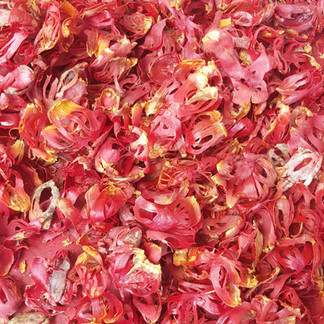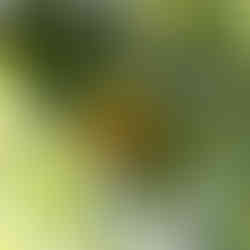Banda: the home of Nutmeg
- Petty Elliott

- Nov 29, 2019
- 4 min read
Visit the tiny remote string of the Banda Islands within Indonesia's archipelago to discover the original source of nutmeg that made it as valuable as gold in centuries past.
Photos: above clockwise from top left: 1. Sliced open nutmeg - the green outer fruit can be pickled or used for jam; 2. the expensive red mace is used in stews and to make perfume; 3. meeting a lady villager selling her mace; 4. fruit on the tree; 5. a 400 year old plantation; 6. all four elements - fruit, leaves, seed and mace - made the versatile nutmeg highly valuable.

The nutmeg tree ‘Myristica fragrance’ actually produces two spices and a fruit. The nutmeg itself, an oval-shaped seed is surrounded by a bright red webbing, known as mace which has a delicate and wonderful aroma, and both are encased in a shell of soft fruit. The unique aroma of the spice nutmeg is unforgettable. It's used widely in soups, main courses, desserts and drinks, forming an essential part of seasonal celebrations in the depths of winter. No wonder it was so sought after in renaissance Europe. My recent journey to the island chain in the sunny tropics, where nutmeg was first discovered over 600 years ago, proved a rich and amazing experience.
Photos from top: the view north to Banda Api volcano, last active in1988; looking south across the Dutch-built fortified warehouse on Banda Naira towards the plantations on Banda Besar; dolphins and whales enroute to Hatta Island ; Looking to the east from the islands of Ay and Run.

Banda Naira lies at the heart of the group with its ancient Dutch fortress, symbolic of the value of nutmeg to the outside world.

Banda Besar has extensive plantations, while to the north the tiny Keraka forms a turning point for sailing to the islands of Ay, Run and Nailakka. And let’s not forget Pulau Syahrir (often called Pisang) and Hatta to the southwest – both named after key figures in Indonesia’s emergence as an independent nation.
Independence was less than 100 years ago but the fame of these islands goes way back to the 6th century and Arab merchants bringing precious cargoes of nutmeg to Constantinople along with cloves from neighboring Ternate. This was the beginnings of Indonesia’s Spice island fame and incredible wealth for all those involved. The fabulous fortunes of Venice were largely built on such spices, in huge demand for their restorative and preservative powers and as valuable as gold in the middle ages. Europeans believed nutmeg had the power to ward off unpleasant viruses and ailments while adding tremendous flavour in the kitchens of the wealthy and influential.
By the 1600s European merchants had established Banda as arguably the most important group of islands in the world. It was an exciting period of exotic stories of sweet-smelling markets, billowing sails, imperial greed, piracy, double dealing and political intrigue. But as history always shows us, nothing stays the same for long. The planting of nutmeg trees elsewhere, the end of Dutch dominance and expansion of world supply meant a decline in value for nutmeg and the disappearance of Banda from world renown.
The best place to see nutmeg trees is on Banda Besar, just a few minutes boat ride from Banda Naira. It’s a pleasant walk from the pier up through the village to a cool, shady forest canopy of ancient Kenari, planted to protect the smaller nutmeg tree. Some Kenari trees are said to be 300 years old or more. Kacang Kenari, the wild local almond from these huge trees is delightful when served floating in hot local coffee – a favourite drink in Ambon or enjoyed in local nougat, mixed with palm sugar syrup.
Most of the communities on each island feature colourful cottages, clean streets and lots of cloves, mace and nutmeg drying on mats in the sun in the front of their homes. Local boat builders were busy, crafting elegant yet sturdy fishing boats in eight weeks or less. These are happy, humble and proud people.
A good, well-covered speedboat is essential for island hopping. In less than an hour we jumped onto the sandy beaches of Ay to visit more ancient nutmeg plantations fringed by the ruins of walls, fortifications and elaborate stone gateways built by the Dutch. Further east lay the island of Run - so famously ceded under the Breda agreement by the British to give the Dutch their much-craved monopoly over the islands. In exchange New Amsterdam, to be renamed New York was handed to the British and I am not sure, comparing the two today, that it proved such a good trade for the Netherlanders.
The cuisine of Banda is of course based around wonderful varieties of fish, often barbequed and served with colo-colo sambal (freshly chopped tomatoes, chilies, lime and sweet soya sauce), or a simpler tomato and chili sambal.
Suami is a cone-shape bread of grated steamed cassava. Fish stews feature the creamy kanari almond sauce. Seafood and sliced nutmeg fruit soup at Maulana Resort proved divine and chilled nutmeg jam made from the fruit and served at the elegant Ciluk Bintang homestay was a delight at breakfast. Familiar national dishes mostly from Java and Sulawesi are also available. Ironically in Banda you won’t find the signature world spice combinations that emerged from nutmeg: there is no speculaas, garam masalah, baharat, pumpkin spice, Chinese five spice or El Ras Hanout here. It’s as if the islanders were oblivious to the role of their home-grown cloves and nutmeg in the outside world.
Today, the Banda islands long forgotten domination of world food trade while an intriguing reason to visit, seems somehow irrelevant to everyday life in what is a quaint, shabby but delightful idyll. Here you’ll find a gentle and simple pace to each day, with little change and that makes it all the more special. Rumours abound of a planned new airport to be constructed on reclaimed land. Yes, it will bring more visitors and add value to local livelihoods, but the pressure on this part of our fragile natural world could prove too much. Banda is still the home of nutmeg and let it be naturally, carefully preserved…. forever.

































Comments